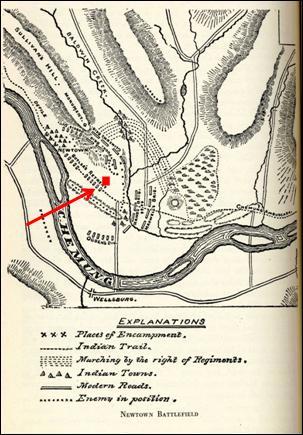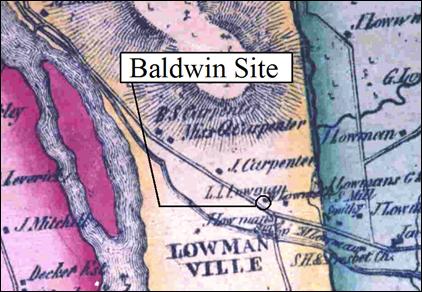The Baldwin site is linked to the Revolutionary War Battle of Newtown, part of the punitive 1779 Sullivan-Clinton campaign against the British allied Haudenosaunee (Iroquois) and Munsee Delaware to eliminate their abilities to aid the British. The Baldwin Site is situated within the battlefield along the Native American trail used by Tory Captain Butler during his retreat.

General John Sullivan wrote: "The enemy had (about a mile in front of town) a very extensive breast-work erected on a rising ground, which commanded the road in which we were to pass with our artillery, and which would enable them to fire upon our flank and front at the same time. This breast-work they had endeavored to masque in a very artful manner, and had concealed themselves behind it in large numbers. I had before been apprised [sic] of the enemy's having a very large encampment at that place. I found that the work was in a bend of the river, which by turning northward, formed a semicircle. There was a deep brook in front of this work over which the road passed and turned off to the right, parallel to the course of the rising ground upon which their works were constructed, which would enable them to flank the line of the march of one column of our troops, had it advanced, without discovering the work" (Wright 1943:1-2).
Among the Continental troops engaged in battle were Isaac Baldwin Sr., and his sons, Isaac Jr., Thomas, Rufus, and Waterman. They were residents of the Wyoming Valley region in Pennsylvania until 1784 or '85, when Isaac Sr. and three of his sons moved to the Chemung River Valley. Historic documents such as the census and tax rolls show that Isaac Sr. and Isaac Jr. operated an inn, store, sawmill, and farm during the 1790s. The fourth veteran of the Newtown Battle was Waterman Baldwin, who had been repeatedly captured by Seneca warriors during prior skirmishes. He developed a friendly relationship with Cornplanter, the Seneca chief, who spared Baldwin's life, taught him the Seneca language, and eventually adopted him. After the war, Waterman Baldwin's relationship with Cornplanter and the Seneca made him a valuable addition to diplomatic exchanges between the Seneca and the United States. Colonel Thomas Proctor described the following encounters with Baldwin, who stayed in Pennsylvania until the late 1790s, and included a description of staying at Isaac Sr.'s inn during a 1791 journey to visit Cornplanter:
This day [March 20] we set forward for Captain Waterman Baldwin's, arrived there in the evening, halted for him part of two days, as I had orders to take him with me to the residence of the Cornplanter, at which place he was intended to act as instructor of the Indian youth, as also a director in the mode and management of agriculture, for the use and benefit of the Indians. This gentleman was made prisoner by Cornplanter, during the late war, and was treated by him with remarkable tenderness, until legally exchanged. Paid for two bushels of oats and two bags, 13s. 1 1/2d. washing, 2s. 6d.; expense at Baldwin's, 30s.
[On March 27] Dined at Mr. Isaac Baldwin's, and halted for the night, and reviewed the ground on which the British and Indians were entrenched, for better than a mile, against the forces under the command of Major General Sullivan. I also saw many traces made by our round and grape shot against them, and a large collection of pieces of 5 1/2 inch shells, which I had the pleasure of formerly causing to be exploded amongst them. Expenses at Mr. Baldwin's for present diet, provisions, and forage, 53s. 910d. (American State Papers, Indian Affairs, 1792:150).
Isaac Baldwin Sr. died that same year, and after a series of intra-family transactions occurred, became the property of Isaac Jr. and his wife, Ruth. The Federal-style homestead addition was reputedly built in 1819, four years after the Baldwins sold the farm to John and Susannah Sly. However, the evidence for the ca. 1819 construction date is scanty, and as Federal-style architecture (1780-1820) had largely fallen out of vogue by then it is possible that the addition was built some years earlier. The Slys retained the farm for 10 years, after which Mary Goodwin and her family owned the property until 1848.
The next owner was not an occupant. George Lowman, son of early settlers Jacob and Huldah Lowman, lived in his own house near the creek. At some point between 1848 and the drafting of the 1853 map, George passed ownership of the property to his son, Lyman L. Lowman. He lived onsite for the better part of the three decades before selling out to his brother, William, in 1869. William and Mary Ann Lowman already lived in their father's house, and census records suggest that the house was occupied by tenants for the remainder of the 19th century.
The current owners of the house are descended from Elmer and Molly Peck, who tenanted the farmstead in the early 20th century and eventually purchased it in 1928.
